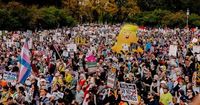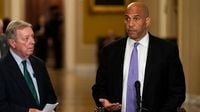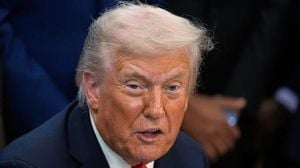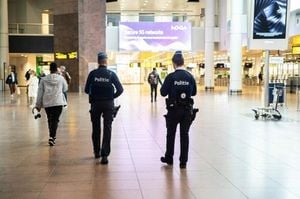On October 18, 2025, the United States witnessed what many are calling the largest single-day protest in recent history, as millions of Americans—joined by demonstrators in Canada, Mexico, and parts of Europe—flooded streets under the banner "No Kings." The slogan, a direct rebuke of former President Donald Trump’s perceived authoritarian ambitions during his second term, united a sweeping coalition of over 200 progressive organizations, from Indivisible and MoveOn to the Human Rights Campaign and numerous labor unions. Estimates put the number of participants between four and six million, eclipsing even the historic 2017 marches that marked Trump’s first term.
The "No Kings" movement, as reported by Pars Today, was not a spontaneous outburst but a meticulously organized campaign. Its central aim? To challenge what protesters describe as Trump’s "authoritarian tendencies," including his public musings about "lifelong power" and alleged efforts to sidestep constitutional limits, such as floating the possibility of a third presidential term. Organizers and participants alike saw these moves as existential threats to American democracy. "America has no king," became both rallying cry and mission statement, as demonstrators called for a restoration of faith in democratic institutions and constitutional norms.
But the protests were about more than abstract principles. On the streets of cities large and small, demonstrators voiced their outrage over a host of Trump administration policies. Strict immigration measures, especially sweeping federal ICE operations in Democratic strongholds, were condemned as heavy-handed and, in the words of many, a form of "military occupation." The deployment of federal forces to control protests and intervene in local governance without consent struck many as a dangerous overreach.
Economic grievances also fueled the movement. Protesters railed against reductions in public services like healthcare and education, and lambasted what Senator Bernie Sanders described in Washington, D.C., as a "billionaire-friendly economy." According to Pars Today, Sanders called for a "fair redistribution of resources," highlighting policies that, in his view, disproportionately benefit figures such as Elon Musk, Jeff Bezos, and Mark Zuckerberg at the expense of ordinary Americans. Allegations of financial corruption and misuse of taxpayer money for Trump’s personal gain were also front and center, with demonstrators demanding greater transparency and accountability.
Prominent figures lent their voices and star power to the cause. Senator Sanders, actors John Cusack and Robert De Niro, and science educator Bill Nye all appeared at events, reflecting the breadth of opposition. Democrats like Chuck Schumer and Cory Booker characterized the protests as an "expression of love for America," while Republicans such as Mike Johnson and J.D. Vance denounced them as a "display of hatred for the country." The divide was further underscored by Trump himself, who mocked the protests in a satirical video, dropping flowers over demonstrators from a fighter jet—a gesture that, if nothing else, underscored the deepening polarization.
One of the most eye-catching aspects of the "No Kings" movement was the sea of inflatable costumes. Across the country, protesters donned frog, chicken, rooster, panda, unicorn, and even T. rex dinosaur outfits. In Portland, Oregon, demonstrators in shark costumes danced outside the U.S. Immigration and Customs Enforcement building, while in Boston, a lobster brandished a sign reading "No shellfish kings." As reported by the Hindustan Times, the costume trend was both a visual spectacle and a strategic move. Mike Nellis, a Democratic strategist, told the Washington Post, "The silliness is the point. All these MAGA guys are out there going, ‘These cities are lawless, they’re dangerous.’ … It’s like you’re matching the absurdity of it."
The costumes served multiple functions. They were a playful counterpunch to claims that blue cities were overrun by crime and violence, and a way to diffuse tension during protests. Brooks Brown, a streamer in Portland, co-founded "Operation Inflation," a campaign to provide free inflatable costumes to anti-ICE protesters. "When you have the inflatables, everyone starts dancing, and even the people who are very serious, they continue what they’re doing, they’re disciplined … but they’re not angry. There’s not an angry vibe behind them," Brown explained. The trend, which began with frogs and evolved to include wiener dogs and giraffes, quickly became a symbol of the movement’s creativity and resilience.
Not everyone was amused. The White House, through spokeswoman Abigail Jackson, dismissed the costumes, saying, "It’s impressive how these ‘protesters’ constantly find ways to make themselves look even dumber." Yet, political strategists across the spectrum acknowledged the tactic’s effectiveness. Terry Sullivan, a Republican strategist, called it "smart" and noted that "it gives extra legs to a story." Stanford political science professor Bruce Cain observed that while the costumes "project frivolity and a party-like atmosphere," they also help "counter the image of the Democratic Party as a violent party." In his view, "If the president is going to invoke the Insurrection Act, he has to go to the court and show them, ‘Here’s some violence.’ It seems to me if you were going to start a fight you wouldn’t want to be looking like Mickey Mouse."
Senator Cory Booker, a leading Democratic voice and potential 2028 presidential contender, played a pivotal role in expanding the protests’ reach. As detailed by The Hill, Booker encouraged red state voters in Florida and North Carolina to join local "No Kings" protests, leveraging interviews with social media influencers like Sara Wiles, Sander Jennings, and Kate Barr, whose combined following approaches two million. Booker’s outreach was not just about protest—it was a strategic effort to pressure Republican lawmakers to end the ongoing government shutdown, which had become a flashpoint in the broader political standoff.
At the heart of the shutdown was a familiar partisan impasse. Democrats demanded an extension of expiring Affordable Care Act subsidies as a condition for reopening the government, while Republicans pushed for a "clean" stopgap bill. Senate Majority Leader John Thune signaled willingness to negotiate, telling MSNBC, "We can guarantee you get a vote by a date certain." But House Minority Leader Hakeem Jeffries remained skeptical, asserting, "Republican leaders can’t be trusted on a wing and a prayer." Booker’s activism, including his record-setting 25-hour speech opposing a major GOP policy bill earlier in the year, underscored the high stakes and the sense of urgency animating the protests.
While the "No Kings" demonstrations brought together millions—young people, veterans, minorities, and celebrities—they also laid bare the nation’s widening political rift. Trump-aligned Republicans, especially those in the MAGA movement, saw the protests as evidence of a historic opportunity to implement a conservative agenda and marginalize liberal voices. For many on the left, the protests were just the beginning—a clarion call to mobilize the "silent majority" ahead of the 2026 midterm elections and beyond.
As the dust settles, one thing is clear: the "No Kings" movement has left an indelible mark on the American political landscape. Whether it will reshape the coming elections or merely harden existing divides remains to be seen, but for now, the message from millions is unmistakable—America, they insist, was never meant to have a king.





